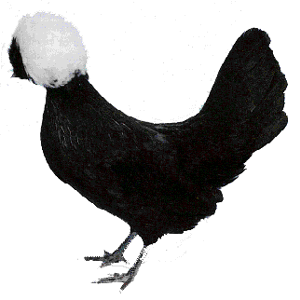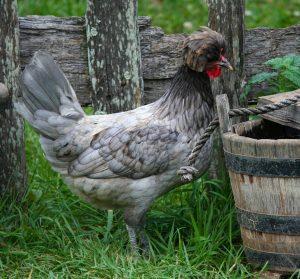
Polish Chicken overview
The chicken with the ‘Pom Pom’ ‘Afro’ ‘Top Hat’ or ‘Top Knot’……. whatever you want to call them, Polish crested chickens are stunning birds that are extremely popular today in backyard flocks!
Where do Polish Chickens come from…?
But, despite the name, experts believe they originate from Holland, not Eastern Europe. This is because these birds are depicted in paintings from the 15th century in Holland. One theory, I like, is that Polish soldiers used to wear feathers in their caps and the birds were named Polish after that. Feathers in caps is still used by armed forces today, including certain regiments in the British Army.
On the Continent of Europe, the name ‘Padoue’ is applied to crested breeds. Charles Darwin classifies all the races of fowl with top-knots as ‘Crested or Polish’ but does not give any data regarding their origin.
Whether they are from Holland or were infact brought to Holland from Poland, as they were so sought after, we will never know. It certainly adds to the uniqueness surrounding this incredible breed.
The French also took a fancy to them, and they were widespread over France at one time. They were exported to the U.S in 1830 and by 1850 were very popular. Famed for their interesting looks and good egg laying ability. Leghorn chickens arrived on the scene though and knocked Polish chickens off the top spot as the best egg layers. The Polish were retained, ofcourse, due to their good looks!
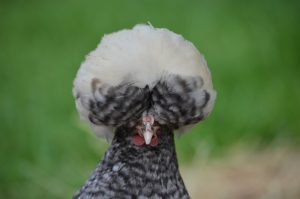
Usually a very calm and friendly bird, so would be great around children. They are good layers of eggs and can be kept in confinement or free range. Find out some more below:
Polish Chicken Eggs
Size
Medium
Color
White
Production per year
180-220 eggs (about 3-4 per week)
When do they start laying eggs?
20-22 weeks old
Polish Crested Chicken Characteristics
Temperament / Are they good as pets?
They make super pets! Not only are they one of the best looking chickens they are fantastic layers – what more do you want. They are very calm and that makes them great with children, but don’t sneak up on them. Their eye sight can sometimes be blocked by the feathers on their head. This means they can be startled and react with flightiness. What I normally do is start talking to them as I slowly approach. Whistling whilst approaching would work great too.
Mine love a cuddle and don’t mind being picked up and handled, so you can really bond with them, which makes them a special breed. Being well handled is also great for feather trimming. A couple of times a year I have to trim those famous head feathers. If left they can cause irritation in the eyes and lead to infections, worst case. They are much happier after as they can see a lot better. If you live in a windy area, it can be worse as the head feathers are blown continually into the eyes. Just something to be aware of.
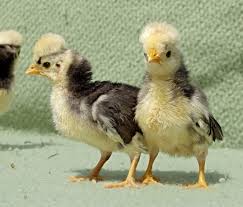
How do I tame Polish chickens?
Well this isn’t hard….they are born super tame! Handling chicks 3-4 times a day is the best way to build up a relationship. If you buy Polish chickens on the POL (point of lay) at say 18-20 weeks, start handling straight away so they begin to get used to you. Ask the breeder who you purchase them from whether or not they are used to being handled too. Always go with chicks or chickens that have been handled they make for much better pets in my opinion.
Treats are great for getting chickens to come over to you. Cupboard love I know – but it works. They are naturally inquisitive anyway, so add some treats and you’ve a recipe for success! Start by throwing the treats or feed on the floor, small bits at a time, soon enough they will eating out of your hands. Mine now fall asleep in my arms…awwww!
How many do I need to buy?
I always say, chickens are social creatures and work best in a minimum of a pair. The best size flock for a backyard is 6. From 6 you can scale up to much more if you like, keeping chickens is fun and addictive. On that note I would purchase a Coop and run that are slightly larger than your current needs. Its all to familiar to get just afew chickens and realise you want many, many more!
The best mixture for Polish birds is 8:1 so that’s 8 females to every one male. This ratio will give you the best balance within your coop.
If you plan to hatch out eggs at home in an incubator, the fertility percentage you will experience will be 40{cfcd481556a8b43fba6af451761032bd323e94372a0c1e607}-55{cfcd481556a8b43fba6af451761032bd323e94372a0c1e607}. This is what nearly all hatcheries will quote you.
The average life span of my Polish Crested and Polish Frizzle Chickens is between 4-7 years. Mine are all free range so keep fairly fit!
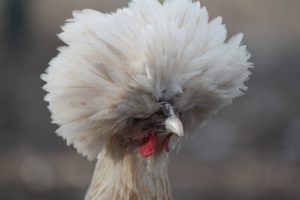
How much space do they need?
Chickens need about 25sqft each in the run. Polish chickens are roughly the same size as a Leghorn for comparison. 25sqft is an average minimum, the more space you give them the happier they are. Polish chickens love being free range and will spend their days happily foraging. This is great as it keeps them active and means they supplement their feed, saving you a pretty penny!
Polish roost at 2-4ft so choose a coop that has roost bars at this height off the floor. Now this is fairly standard for most chicken breeds, but make sure they have enough head room too. The feathers on their heads can grow to over 3 inches (7.6cm) so take that into your coop considerations. Well we all like to be comfortable when sleeping, Polish chickens are no different!
Will they mix with my other chickens?
Yes, being a fun docile breed they will mix well with other chickens. Breeds that they particular enjoy being around are:
- Silkies
- Bantam breeds
- Australorps
- Orpingtons
A word of warning however, if introduced into a flock of very alert, active birds like Welsummers or some Rhode Islands; Polish chickens can get picked on.
Its not called the pecking order for no reason. Polish hens tend to be fairly low down that pecking order. They can pecked on their heads and the feathers from their lovely crest plumage pulled out. You therefore, have to keep an eye on them when introducing them to an existing flock. There will at first, be a little bit of unsettledness, as the new birds find their place amongst the existing hierarchy. This should all settle down fairly quickly however. If it doesn’t and you see bullying or evidence of bullying, unfortunately they will have to be separated.
Appearance
Polish crested chickens have white ear lobes, red wattles and although rarely seen a red ‘V’ comb. They are of course famous for their ‘crest’ the feathers that grow from top of their head. Not many people know but they have large cavernous nostrils that are found only in crested breeds. But did you know you can get bearded polish chickens too……yes chickens with beards!
There is such a huge variety of Polish chickens but not all are recognised by the American Poultry Association. Varieties that aren’t included are the white-crested khaki, white- crested blue splash, black- crested blue, black-tailed red, crele, harlequin, self black, self chocolate, splash, white-crested buff, black-crested buff, white-crested dun and the white-laced red.
Although not recognised by the APA there are some absolutely gorgeous varieties within that list I think my favourite is either the self-chocolate or the white crested blue splash.
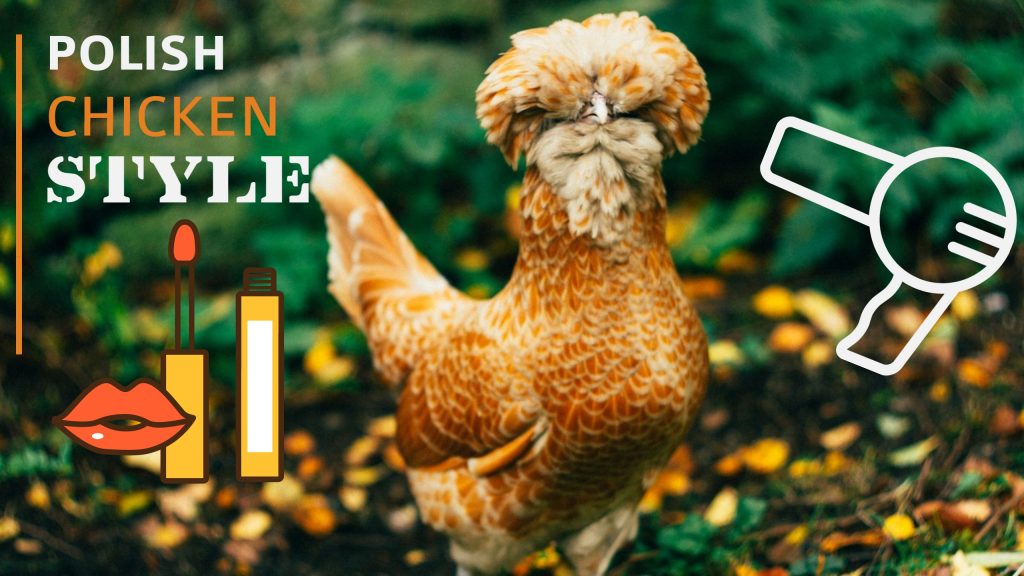
The blue, buff, buff laced, golden, silver laced and white all take their color as standard from their name. These are accepted by the APA.
The list of APA accepted crested Polish chickens is below:
- Black Crested White Polish – as it sounds; white plumage, except for the lustrous black crest.
- White Crested Black – Plumage is lustrous black, bar the crest which is white.
- White Crested Blue – Plumage is blue, apart from for the crest which is white.
- White Crested Chocolate – Plumage is milk to dark chocolate with a neutral sheen, except for crest, which is white.
- White Crested Cuckoo – Plumage is barred in white and blue, the crest is white.
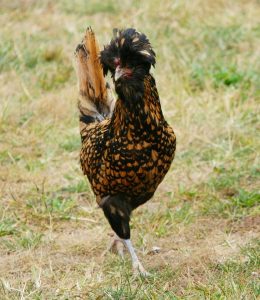
Polish Frizzle Chicken
Let’s not forget this amazing beauty! For those unfamiliar a frizzle is breed of chicken that has frizzled, or curled feathers. Instead of running smoothly along the body their feathers ‘curl up’ and give the appearance of a soft fluffy coat. Add in a Polish crest and you probably have one of the most unique looking chickens in the world. The Polish frizzle, which can be rare, leaves everyone speechless!
Feeding
What should I feed them?
Chicks will need to be fed chick crumb upto 6 weeks old. A little tip you can mix in a bit of water to soften it up if they are struggling. From 6 weeks onwards move them onto growers mash. Growers pellets do the same job they are just in a pellet form. Make this transition by phasing out one and phasing in the other in their feeder. One or two days and they should be used to the new feed taste and smell.
At around 16-18 weeks they will begin to need a different feed. One that contains all the right nutrients they will need for laying your wonderful eggs! I make the switch to layers pallets slightly early so they have plenty of energy when they do lay there first egg as its very demanding on their bodies in the early stages. They will then then eat layers pellets until they stop laying usually about 1 year before the end of their lives. Some people carry on feeding them layers pellets when they have stopped laying some don’t, its preference. If you have other chickens eating layers pellets then it’s probably easier to just carry on. It’s what they are used to after all.
With the layers pellets, I mix in some corn. Corn will help to keep them warm and give them energy during the winter. This is especially good if you live in an area that has cold winters, as Polish chickens aren’t cold hardy. Meaning they get cold easily. Chicken cant warm up with a nice cup of tea or coffee so its all down to what they eat and the shelter i.e the coop that you provide. Corn and seeds are therefore great during winter to supplement their diet. During summer they will forage a lot and eat lots of worms, insects and grubs found in the grass.
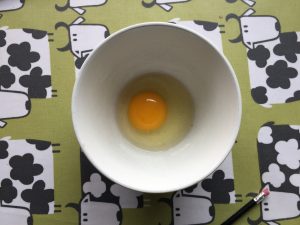
How much should I feed them?
As chicks and right up to laying their first egg, I have food available at all times in a feeder. Fresh water too, I might add! They haven’t at this stage got used to being in a routine so need feed there all the time, as they are growing so rapidly.
Adults will eat between 2.8oz. (80g) and 4.2oz. (120g) per day. During summer maybe slightly less as its hot and they will drink more water. Then as mentioned more during the winter slightly more to keep warm. During the summer I recommend high water content fruit and Veg to supplement their diet. Mine love watermelon! Chop up small bits so that they don’t get their crests in the watermelon juice as it will go sticky and cause issues like flys etc. Apples are great to, along with pears, healthy treats are always best.
What can’t they eat?
Good question – this applies to all chickens not just the Polish breed, they can’t eat beans or chocolate. Sadly they cause chickens to cardiac arrest. Beans and dried beans are the worst type, can sometimes sneak in if you feed them table scraps. So be really vigilant if you are going to feed them from the table.
Also they love being free range and go off wondering so make sure they can’t come across any beans plants growing in a vegetable patch. Either your vegetable patch or the neighbors!
Oh and do them a favor and eat the chocolate yourself, so they cant!
Hop on over to our chick and chicken feeds page for all the indepth info by clicking here
What do I need to keep Polish crested and frizzle chickens?
To keep chickens you’ll need the BIG 3 check them out below:
-
A Coop
Not a cold hardy breed so make sure its well-insulated with good head room. They can be a noisy breed so again well insulated is definitely better than not. Polish chickens roost at 2-4ft during the night. So you will need a coop that has the correct roosting bars to suit, again don’t forget head room for those lovely crested feathers.
Good ventilation is often so overlooked. Its actually really important, but choose a coop that doesn’t have vents in front of the roosting bars. This is so they don’t catch a chill in the night during cold winters.
-
Waterer
Now the plumage on their head, if I gets wet and its cold could cause headaches. It could, in winter, potentially freeze too. Not great, so you can’t keep an waterter on the floor. It will have to be one that can be hung, this is common and lots of place sell them. It needs to be hung at the ‘back height’ of the birds, so its easily accessible for the birds to drink from. Fresh water should be provided daily, and id always recommend a metal waterer.
Put simply they last a lot longer. I had a plastic one that lasted only a year as in the sunlight and cold they crack easily. My metal one is over 15 years old. Nothing can leach from the metal ones either, plastics can and it will contaminate the water. Plus too chickens actually prefer cool water. A metal waterer will keep water cooler for longer compared to a plastic one.
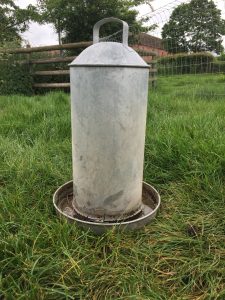
3. A Feeder
Now ok, you can throw chicken feed on the floor and I do it, but here’s why you shouldn’t! It immediately attracts rodents and with them comes diseases and bad hygiene that will spread quickly amongst your flock. Feed also goes bad very quickly on the floor and chickens shouldn’t eat spoiled feed.
What I do is this, I place most of the feed into the feeder and scatter some on the ground each day. This keeps them entertained and happy scratching around and pecking for it. But I only do this on dry days so the feed doesn’t spoil, gets left by the chickens, and then attracts rodents.
It’s a metal feeder all the way for me. Same issues as the waterer, they last a hell of a lot longer than plastic ones. Imagine all your chickens pecking each individual bit of feed out of the feeder each day for year. That’s a lot of pecking and they crack real easy I’m afraid. You’ll get 10 to 20 times the lifespan from a metal one anyway, it’s a no brainer.
Polish chickens for sale
U.S
Cackle Hatchery was started in 1931 and has been hatching & breeding 7 different types of Polish chickens since 1971. They have the best stock of Polish birds. Super friendly, very helpful and they ship country wide out of Missouri!
Check out their awesome Polish breeds here for yourself.
U.K
I’d try ‘poultry trader’ just search that on Google, it will bring up a bunch of results.
Polish chicken F.A.Q’s
Are Polish chickens friendly?
Yes Polish chickens are very friendly, they are calm and docile and are great around children. They are also friendly around other chickens and mix well within an existing flock.
Are Polish chickens noisy?
Polish chickens aren’t the noisiest breeds of chickens. On a scale of 1-10 they are a 6.5. The crow of a male Polish rooster isn’t extremely loud either.
